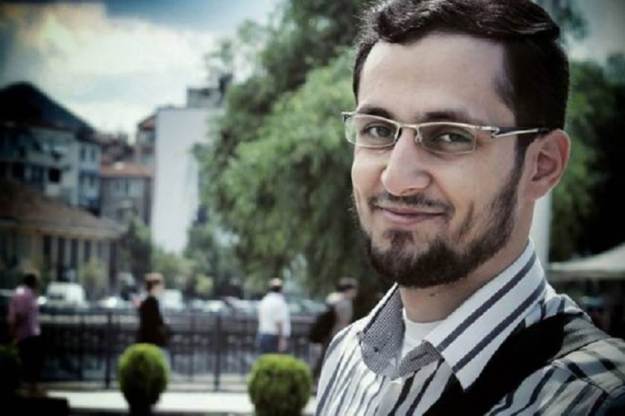By Kyle Orton (@KyleWOrton) on 29 July 2017

Baraa Kadek (Riyan Meshal) [image source]
The most important name on the CENTCOM list is Baraa Kadek (Riyan Meshal), identified as a “senior media official” in IS, the “head and founder of Amaq, ISIS’s official propaganda media outlet”. In this role, Meshal “oversaw, authorized and disseminated ISIS digital propaganda to instigate and direct terror and recruit foreign terrorist fighters”. IS’s foreign intelligence service, Amn al-Kharji, has worked through Amaq to guide terrorist attacks in the West and beyond. Amaq has then been the vehicle through which IS claims these attacks in a stereotyped manner, about which new details emerged this week. Kadek was killed between 25 and 27 May, according to CENTCOM. Kadek had been reported dead in late May, around the time Turki al-Binali was killed, but the date was given as 29 May.
The Coalition has destroyed several key operatives in IS’s media department, which is intimately linked to its recruitment and foreign terrorism operations, over the last year. The most well-known is probably Taha Falaha (Abu Muhammad al-Adnani), the caliph’s deputy and IS’s official spokesman, who approved the external attacks. Falaha was killed in August 2016, swiftly followed by IS’s internal propaganda manager Abu Harith al-Lami and Wael al-Fayad (Abu Muhammad al-Furqan or Dr. Wael al-Rawi), the head of the media department and one of the board members for Amaq. In January 2017, a protégé of al-Fayad’s, Ahmad Abousamra (Abu Sulayman al-Shami), was killed. Abousamra, a Syrian-American jihadist, was to IS’s English content what Kadek had been for Arabic, functioning, among other things, as the chief editor of Rumiyah, IS’s English-language magazine to replace Dabiq.
It is also notable that Kadek was killed in Mayadeen. Since April, according to CENTCOM statements, at least four important operatives of IS’s external operations division have been killed in Mayadeen. Mustafa Gunes, a Turk, was a recruiter in the Turkish city of Konya and working as “external operations facilitator”, “linked to facilitating financial support for planning attacks outside Syria and Iraq against the West”, when he was killed on 27 April. Abdurakhmon Uzbeki, a “close associate” of the caliph’s and a facilitator of the Reina nightclub atrocity in Turkey on New Year’s Day, was killed on 6 April. Abu Asim al-Jazaeri, killed 11 May near Mayadin, was a French-Algerian who was involved in the “Cubs of Caliphate” program that indoctrinates children. And Samir Idris, a “key ISIS financial facilitator for external terror attacks and an international money launderer”, whom IS’s leadership “trusted … to move funds across borders to pay for external terror attacks”, was killed on 7 June.
The Coalition killed Ibrahim al-Ansari, an “ISIS propaganda official”, in an airstrike on 25 March 2017 in al-Qaim, the Iraqi border town that has been the gateway for foreign jihadists transiting Syria to get to IS for fifteen years. Ibrahim al-Ansari’s demise had “previously [been] announced” by the Combined Joint Task Force-Operation INHERENT RESOLVE (CJTF-OIR), as the anti-IS Coalition is formally known, on 31 March.
Abu Ali al-Janubi, “ISIS’s senior media director”, was killed by a Coalition airstrike in Mayadeen, Syria, on 16 April 2017.
Another strike on al-Qaim on 27 April 2017 eliminated Abu-Sayf al-Isawi, “an ISIS media emir”.
Abu-Khattab al-Rawi, also “an ISIS media emir”, was struck down in al-Ba’aj, west of Mosul in Iraq’s Ninawa Province, on 17 May 2017. CENTCOM had reported this on 26 May.
A “senior ISIS propaganda official”, Abu Sulayman al-Iraqi, was eliminated in “early July” by a Coalition airstrike near Mosul. Abu Sulayman had “provided strategic guidance and production oversight for ISIS propaganda that recruited, indoctrinated and directed terrorists around the world”.
A Coalition airstrike in Mayadeen on 18 July 2017 killed Bassam al-Jayfus, who “handled ISIS funds for terror attacks”. According to CENTCOM, the removal of al-Jayfus “causes a disruption to ISIS’s multi-national money laundering network, which is used to pay for foreign terrorist fighters as well as terror plotting and attacks throughout the world”. In tandem with the killing of IS financier Fawaz Jubayr al-Rawi in June in al-Bukamal, the town on the Syrian border opposite al-Qaim, and the recent U.S. sanctions against Umar al-Kubaysi, an IS financier and facilitator operating in the Iraq-Syria border area, it suggests the U.S. is gaining some insight into IS’s financial infrastructure.
What is noticeable is the concentration of these senior IS officials in Mayadeen and al-Qaim, an area IS calls Wilayat al-Furat (The Euphrates Province), the only one of IS provinces that straddles the Iraq-Syria border. The town of Mayadeen, around one-hundred miles down the Euphrates River Valley from Raqqa city, IS’s Syrian “capital”, became the administrative centre of the caliphate in February, ahead of the Coalition-backed operation to evict IS from Raqqa. The movement of IS’s senior leadership downriver into Wilayat al-Furat was detectable last year. This area covering Deir Ezzor and western Anbar is now the last redoubt of the caliphate, a physical shelter for Ibrahim al-Badri (Abu Bakr al-Baghdadi) and the final territorial holdings that allow him to claim the mantle of caliph.
Originally published at The Henry Jackson Society
Pingback: Coalition Targets Islamic State Recruiters and Terrorism Planners | The Syrian Intifada
Pingback: Coalition Kills Two Islamic State Weapons Engineers in Syria | The Syrian Intifada
Pingback: The Coalition Removes Senior Islamic State Leaders, Military Officials, and External Terror Operatives | The Syrian Intifada
Pingback: Coalition, Hindered By the Syrian Regime, Kills Islamic State Leaders | Kyle Orton's Blog